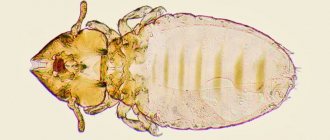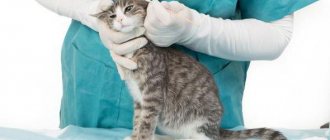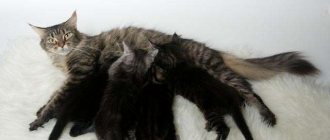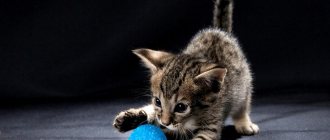If your cat often itches, chews itself, and has poor sleep, then these are probably symptoms of lice infestations. Lice eaters are parasites that live on the body of animals and cause them a lot of inconvenience. The appearance of lice can lead to more serious illnesses in the cat, so they should not be ignored. Do cats have lice eaters, what do they look like, and how to remove them can you find out in this article.
Who are the lice eaters?
Lice eaters are parasites that are not blood-sucking insects, and they feed on skin particles, animal fur, and skin secretions of warm-blooded animals. Unlike fleas, these parasites do not suck blood from the animal's skin. The lice eater looks completely different from fleas, although some pet owners confuse them. Lice eaters are yellow or gray in color, their body size is only 1-2 mm. They have a large head, a biting apparatus in the mouth, and paws on the body that allow them to hold onto the fur.
The lice eaters multiply rapidly, because the female lays about a hundred eggs at a time. At the same time, she attaches them to the animal’s fur using a special adhesive substance. Combing the eggs with a comb or washing them with water will not work.
These parasites are less mobile than fleas; they cannot jump, but only crawl.
Reasons for appearance
Routes of infection:
- in close contact with a sick animal,
- through care products,
- from mother.
Poor living conditions (high humidity, lack of ventilation, insufficient lighting, etc.) contribute to a decrease in the animal’s immunity and the progression of the development of ectoparasitic invasion. Sometimes the owner can bring parasite eggs from the street on clothes or shoes (since a sick animal is constantly itching, some eggs peel off from the fur and fall on the ground).
The favorite places of these parasites: in dogs - the root of the tail, the inner surface of the thighs. Cats have a head, neck, and tail.
Upon careful examination, you can see adult insects and their eggs - white grains attached to the root part of the hair.
Signs of parasites
It is difficult to see them with the naked eye due to their light color, but there are signs by which their presence can be determined:
- frequent itching;
- the cat is restless, sleeps poorly;
- the cat often licks its fur and tries to chew out parasites with its teeth;
- the skin on the cat’s body peels off and wounds appear;
- The hair falls out a lot, and bald patches of skin appear.
If your cat has the above symptoms, you should carefully examine him at home. Lice eaters live in cats' fur, and they stick to their eggs in such a way that it is difficult to comb them out.
In order to see these very small insects, you need good lighting. They also like warmth, and if you sit your cat near a heater, they will be easier to see because they will emerge on the ends of their fur. If you find these parasites on your pet’s skin, you should immediately take him to see a veterinarian. Only a doctor can correctly suggest a drug that will get rid of parasites and will not harm the animal.
Help from specialists
If you notice that your dog or cat is constantly and painfully itching, going bald and eating poorly, do not delay a visit to the clinic. Delay in treating lice can lead to the development of eczema, complete baldness and exhaustion of the pet. Decreased immunity can lead to death in the long term.
Specialists from the network of veterinary clinics “Svoy Doctor” will examine your pet, conduct a study and prescribe the optimal treatment. Contact the branch nearest to you in Moscow or another city for help.
How dangerous are lice eaters?
These pests can be dangerous to your pet's health because they can cause serious illnesses. Lice eaters can transfer endoparasite eggs to the pet's skin, which leads to helminthiasis. This disease leads to depletion of the cat's body.
A disease such as trichodectosis may also occur, the symptoms of which are not only itching, but also severe hair loss. Due to the damage to the pet's skin by lice eaters, wounds remain on it through which bacteria can enter the cat's blood.
The cat hair eater is not dangerous for people, because the human body temperature is too low for them, and they die from the cold. Lice-eaters are not transmitted to humans, even through direct contact with an infected cat.
Danger and consequences for cats
Infection with lice eaters is called trichodectosis (mallophagosis). Insects make your cat itchy, so she scratches her skin vigorously. Hair falls out at the site of scratching, and hyperkeratosis may develop - a thickening of the stratum corneum of the epidermis.
The presence of parasites on the body can cause allergic reactions in a cat; if there is a massive infection, the animal becomes lethargic, apathetic, and loses its appetite.
If a cat has chronic pathologies, then infection with lice eaters can provoke their exacerbation.
Lice eaters not only cause pain and discomfort to the cat, but are also carriers of the larvae of other parasitic organisms, for example, the pumpkin or cucumber tapeworm. This tapeworm, which causes the dangerous disease dipilidia, lives not only in the body of animals, but also in humans. This type of helminthiasis can be transmitted from pets to humans through close contact.
Lice eaters under a microscope
How to treat
When lice eaters have already been detected in cats, it is necessary to begin treatment as soon as possible. Now in the assortment of veterinary pharmacies there are many antiparasitic and therapeutic agents that will allow you to remove lice at home, because they are not transmitted to humans.
If lice bites appear in a cat, you should not delay treatment, and you should not skimp on medications. It is best to go to an appointment with a veterinarian who will offer high-quality and proven medications for treatment.
Use of drugs
The following remedies can be used for treatment:
- Spray and drops. Treating a cat with a spray is convenient and quick, and this method is one of the most effective. The spray is sprayed onto the pet's skin in the direction against the fur. Applying the drops also does not require much effort. The drug must be applied to the cat’s withers so that it cannot lick it off.
- Shampoo. This product is the safest for your pet, but not very effective. You may not be able to completely get rid of parasites with shampoo, but their number will definitely decrease. It is necessary to apply shampoo to the cat's wet fur, lather it, then leave it on the animal's body for five minutes, and rinse with warm water. For greater effectiveness, it is necessary to repeat the procedure.
- Collar. A parasite collar is quite effective; you just need to put it on your pet’s neck. But this method is more suitable for protecting against the appearance of parasites than for removing them.
- Pills. There are also tablets that allow you to get rid of not only lice eaters, but also other parasites.
- Emulsion. To use the emulsion, you need to prepare a solution according to the instructions for the drug and rub it into the pet’s skin.
The most famous and effective drugs are the following brands: Stronghold, Bars, Bio-Grom, Bayer. Most often, antiparasitic drugs not only remove parasites, but also protect cats from their attacks for 1-3 months. When using any drug, you must carefully study the instructions and follow them exactly in order not to harm the cat. The procedure is repeated at least twice, because after the first treatment, parasite eggs will remain on the wool. The interval between procedures should be 14-20 days.
Folk remedies
If your cat has sensitive skin, then it is best to use folk recipes to get rid of hair lice; a solution of wormwood or chamomile is especially effective. Traditional treatment helps only at the initial stage of infection, and can also be used as a preventive measure. Before you begin removing lice, you must consult a veterinarian.
Removal methods
To combat lice eaters, the same methods are used as in the case of other ectoparasites - lice, fleas, ticks. Parasites spend their entire lives on animals, so the fight against them comes down to destructive measures. It must be borne in mind that all insectoacaricidal agents do not destroy eggs. To achieve a positive result, use long-acting medications or treat the cat’s coat twice, with an interval of 10–12 days. To improve well-being, the affected areas of the skin are treated with Stop Itching spray. When choosing insectoacaricides, adhere to the following rules:
- select only those drugs that are intended for cats;
- Not all lice-eating products are suitable for kittens;
- 3 days before treatment and 3 days after it, the animal cannot be bathed, unless the instructions for use require otherwise;
- To prevent the cat from licking the applied product, to do this, isolate it from other animals and put on a cervical collar for half an hour.
To destroy lice, lice, ticks, and fleas, the following types of insectoacaricides are used:
- aerosols;
- Spot-on drops;
- shampoos;
- flea collars;
Aerosols
For ease of treatment of cats, aerosol preparations are used. The instructions describe in detail how many presses on the spray head need to be made depending on the weight of the pet. Some medications can be used for pregnant and lactating cats, as well as kittens. Other remedies have restrictions based on age and physiological condition. Aerosols against fleas, lice, ticks and lice are in demand:
- Frontline;
- Hartz;
- Leopard;
- Bolfo;
- Fiprist.
Aerosols protect cats from ectoparasite attacks for 4–6 weeks. Gloves should be worn when working. Do not allow the liquid to get into your pet's eyes. Inconvenient places are treated with a finger dipped in the solution.
Drops Spot-on
Spot-on means “straight to the point.” Insectoacaricidal drops are packaged in dosed pipettes and applied to intact dry skin in the area of the back of the head or withers, in a place that the cat cannot reach. However, if there are other animals in the apartment, the pet should be isolated for half an hour. Complex preparations that protect not only from ectoparasites, but also from helminths, including heartworms, which are dangerous to humans, which are carried by mosquitoes, as well as cucumber tapeworm, are becoming increasingly popular.
The following drugs are in demand:
- Stronghold;
- Helmintal;
- Advocate;
- Inspector;
- IN-AP is a complex.
Shampoos
Detergents contain mainly repellents, insect-repellent components isolated from plants. They are non-toxic, repel ectoparasites, but do not protect against re-attack. Therefore, they can be used for kittens. The following zoo shampoos are popular:
- Rolf club;
- Lugovoy;
- Four with a tail;
- Beafar;
- Dana.
Anti-flea collars
Flea collars provide the longest protection against ectoparasites. However, most of them are toxic to kittens. Therefore, for this category of pets, as well as for lactating cats, you cannot wear an insecticidal neck tape. The following brands are popular among pet owners:
- Celandine;
- Bolfo;
- Beafar;
- Leopard.
Prevention
The following preventive measures exist:
- It is necessary to avoid contact of the cat with other homeless animals;
- Regularly inspect your pet's fur;
- Keep your pet's bedding, house and slicker clean;
- Monitor your cat’s diet and provide him with enough vitamins;
- Every 2-3 months, bathe the cat, and it is advisable to use anti-parasitic shampoo;
- If the cat goes outside, then it is necessary to put an antiparasitic collar on it, which will protect it from lice eaters, as well as from fleas.
Following these simple rules will help avoid the appearance and re-infection of these parasites.
VIDEO “We use drops against lice”
In this video you can learn how to properly use drops to fight external parasites in cats.
Was this article helpful?
Thank you for your opinion!
The article was useful. Please share the information with your friends.
Yes (100.00%)
No
X
Please write what is wrong and leave recommendations on the article
Cancel reply
Rate the benefit of the article: Rate the author ( 8 votes, average: 4.88 out of 5)
Discuss the article:
Diagnostics
No special diagnostic procedures are required to make a diagnosis. If desired, the owner of an infected cat can independently visually determine the presence of ectoparasites on its fur before visiting the veterinarian.
Having noticed lice eaters in a cat's fur, it is quite possible to mistake them for fleas. To distinguish lice eaters from fleas, you need to heat the cat's fur (this can be done with a special lamp, near a battery, or simply under the sun's rays). Lice eaters strive for warmth and will crawl to the surface, unlike fleas. It is then that they can be seen using a magnifying glass.











